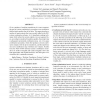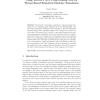247 search results - page 9 / 50 » Predicting Success in Machine Translation |
ICASSP
2010
IEEE
13 years 7 months ago
2010
IEEE
Given a number of machine translations of a source segment, the goal of system combination is to produce a new translation that has better quality than all of them. This paper des...
NAACL
2010
13 years 5 months ago
2010
The distortion cost function used in Mosesstyle machine translation systems has two flaws. First, it does not estimate the future cost of known required moves, thus increasing sea...
IALP
2010
13 years 2 months ago
2010
The hierarchical Pitman-Yor process-based smoothing method applied to language model was proposed by Goldwater and by Teh; the performance of this smoothing method is shown compara...
ACL
2006
13 years 9 months ago
2006
Certain distinctions made in the lexicon of one language may be redundant when translating into another language. We quantify redundancy among source types by the similarity of th...
TSD
2010
Springer
13 years 5 months ago
2010
Springer
Abstract. We present a systematic comparison of preprocessing techniques for two language pairs: English-Czech and English-Hindi. The two target languages, although both belonging ...


